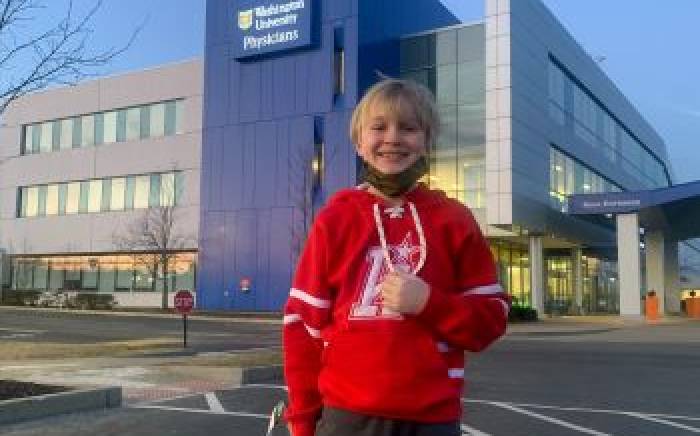 In March 2016, Leo Martin contracted a virus, but as a child with a history of asthma and allergies, his parents, Claire and Jason, had seen him sick before. After about a week they thought he had recovered, but this time something was different with their son, who was 9 years old at the time.
In March 2016, Leo Martin contracted a virus, but as a child with a history of asthma and allergies, his parents, Claire and Jason, had seen him sick before. After about a week they thought he had recovered, but this time something was different with their son, who was 9 years old at the time.
"We quickly learned that his autoimmune system malfunctioned for some reason, and within 24 hours, he went from saying his leg hurt to almost total paralysis,” Claire says. “We rushed Leo to the St. Louis Children’s Hospital emergency room early in the morning, and after 24 hours, he was moved to the pediatric intensive care unit.”
After numerous tests and an MRI that Claire credits with saving his life, Leo was diagnosed with acute disseminated encephalomyelitis (ADEM), an intense attack of inflammation that affects the brain and spinal cord.
“We were told this was a very rare disease and Children’s only sees about eight of these cases a year,” Claire says.
While in the PICU, Leo underwent multiple plasma pheresis treatments led by Washington University pediatric neurologist and St. Louis Children’s Hospital (SLCH) neurologist-in-chief Bradley Schlaggar, MD, PhD. Leo then became a patient of Soe Mar, MD, a Washington University pediatric neurologist at SLCH, who specializes in ADEM.
Claire recalls the first time she saw movement in Leo’s toes. “My husband and I were elated when he started wiggling his toes,” she says.
Leo’s early movement led to his transfer to the neurorehabilitation service on the 12thfloor. Led by pediatric neurologist Michael J. Noetzel, MD, the neurorehab program is an accredited, comprehensive program that brings together physicians, nurses, therapists, child life specialists, social workers, and otherexperts in the care of children with complex neurologic injuries. Early in his rehabilitation, Leo met physical therapist Toni Goelz. Goelz, along with her fellow occupational, speech and music therapists, provides therapy to children either in their rooms or in a gym within the unit.
“Toni came in like sunshine with a rainbow, and she changed everything. She was an angel,” Claire says. “Leo literally had to start over, but he made tremendous strides every day thanks to the therapists and the care he received.”
Leo’s right side was weaker than his left and his arms were stronger than his legs. But with the added support and stability of his feet and ankles using braces, he progressed rapidly and went from walking with a walker to a straight cane when needed.
“We define goals with our patients and review them with the team each week,” says Goelz. “One of Leo’s goals was to visit the Olson Family Garden, a favorite place for many neurorehab patients, and cross the stepping stone path. The garden provides different surfaces and ramps that help patients reinforce their goals.
“It was very important for him to go back and walk on the stepping stones, and he reached that goal,” says his mom. “He also loved music therapy and having his favorite songs playing in the background while he was doing other therapies. He especially appreciated when the music therapist, Christy Merrell, would visit his room when he was having a bad day.”
In addition to therapy services , Leo benefitted from the hospital’s schoolroom, playroom, teen lounge, Olson Family Garden, and Family Resource Center.
Therapeutic community outings are planned by the care team and coordinated by child life specialists for those children who are able. These range from a visit to the nearby Central West End neighborhood for lunch to an outing at a local mall or the Saint Louis Zoo.
“Leo was able to go out to lunch in his wheelchair with the whole therapy team, and he loved that,” Claire says. “He also adored the touch dogs that would visit every day.”
Even after children are discharged from the program, many return to see their therapists at the annual neurorehabilitation reunion. Leo attended his first reunion, which was held at the Magic House, last fall.
Fortunately for the Martin family, who also have 7-year-old daughter, Eleni, Leo returned home by mid-April. Leo will be followed for the next five years and the family is reassured that this condition should not happen again.
“He’s just back to being a normal little boy. He’s in the fourth grade now and loves the Cardinals, playing baseball and soccer, riding his scooter, playing with his friends and math,” Claire says. “If it wasn’t for St. Louis Children’s Hospital, the doctors, nurses, and the neurorehab therapists, I don’t know what would have happened to Leo.
She adds, “I’m not sure how everyone at Children’s does what they do, but it has to be because of children like Leo that give them a reason to get up every day, to see a child heal.”









